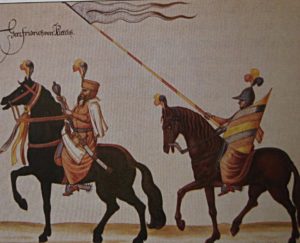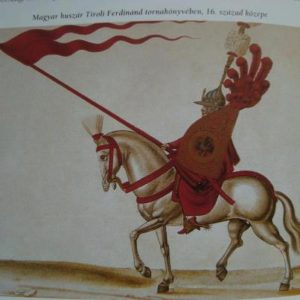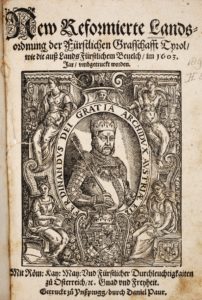The Hussar tournaments of Ferdinand II, Archduke of Austria



It is perhaps not so well known, but it is a fact that Ferdinand of Tyrol was a lover of knightly martial arts and jousting tournaments, a tradition he probably ‘inherited’ from Emperor Maximilian I. The fact that he was also obsessed with Hungarian Hussar fighting and jousting (one might say so, since he not only organized a series of ‘Hussar tournaments’, but also passionately collected Hussar weapons, equipment, and even relics, portraits, etc. of great heroes of the time) is something that Tirolian Ferdinand was passionate about. It can be seen no longer as a decadent nostalgia for a bygone age (the age of the knights) but as a current political message or program aimed at mobilizing people to fight the Turks.

It is worth noting that Archduke Ferdinand of Tyrol acquired for his collection the saber and helmet of Zrínyi, the hero of Szigetvár (1566) which was transferred to the collections of Innsbruck and Vienna. According to research – most recently thoroughly researched by Gulyás Borbála – the Archduke held at least five such tournaments between 1548 and 1557: they were the “Hussarisches Turnier.”

The Hungarian Hussars – as a light cavalry – became generally known beyond the borders of the country, see the deeds of the Hungarian Hussars in the Schmalkalden War. Without them, the Habsburgs would have had difficulties defeating their Protestant opponents. Also, Archduke Ferdinand of Tyrol was an important player in the battles twice against the Turks here in the Kingdom of Hungary. Both times were in battles in which the Turks aimed to take Szigetvár castle – the first unsuccessful one in 1556 and the great siege ten years later.
Note: In the summer of 1556, Archduke Ferdinand of Tyrol was present – with several Hungarian dignitaries – in the war that achieved the liberation of the besieged castle. However, ten years later in 1566, he did not move from Győr castle, remained idle, and just watched the heroic fall of Szigetvár castle. You can read more about the first siege (1556) of Szigetvár on my page:
https://www.hungarianottomanwars.com/1541-1699/the-siege-of-szigetvar-in-1556/

The Archduke himself also took part in the Hussar tournaments, wearing a red and green fringed “dolman” and “mente” (traditional Hungarian short- and long clothes), a combat helmet decorated with feathers and oriental motifs, and a large mustache which was, of course, a false one. We do not have a complete picture of the course of these tournaments, nor do we always know who the participants were.

In most cases, foreigners donned these exotic outfits which were Turkish, possibly Moorish or Hungarian ‘costumes’. They fought in the Hussar style, first with their spears (“kopja”) and then with sabers. There were Germans, Czechs, Italians and some French among them… The Hussar tournament held in June 1549 – also in Prague – was recorded to have included Hungarian officers such as Balassa János (father of Balassi Bálint), Macedonian Péter and Török János of Enying (son of Török Bálint). (Please, note that I use the Oriental name order for Hungarians where family names come first.)

The popularity of the Hussar Tournament was increasing: for example, Maurice, Elector of Saxony, who also took part in the Hungarian battles (1548, 1552, 1553), tried to establish the Hussarisches Turnier at his residence in Dresden, perhaps in imitation of the Archduke of Tyrol.



„Mummerei und Sarmatie…” 1552

The most interesting thing about the tournament, which took place in Budyně nad Ohří at the end of 1552 – on 27 December to be precise – is that the “Turkish” players fought with “Slavic knights”. The Hussar tournament became known as ‘Mummerei und Sarmatie, Komödie und Turnier’.


You can read more about Hussars and their tactics here:
https://www.hungarianottomanwars.com/essays/horses-of-battle/
Dear Readers, I can only make this content available through small donations or by selling my books or T-shirts.
If you like my writings, please feel free to support me with a coffee here:
You can check out my books on Amazon or Draft2Digital, they are available in hardcover, paperback, or ebook:
https://www.amazon.com/dp/198020490X
or at https://books2read.com/b/boYd81


My work can also be followed and supported on Patreon: Become a Patron!http://Become a Patron!


https://hungarianottomanwars.myspreadshop.com/all


